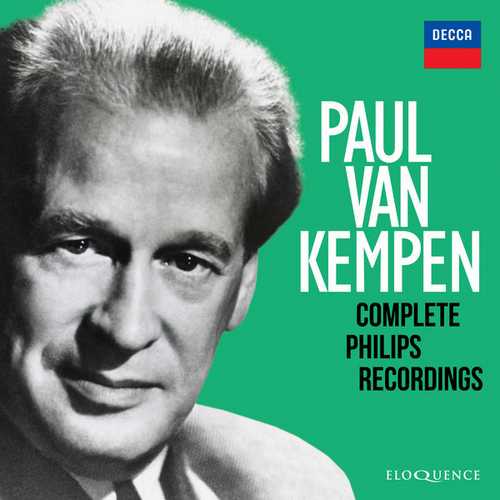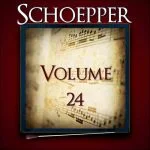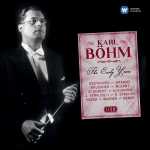
Composer: Ludwig van Beethoven, Hector Berlioz, Johannes Brahms, Gaetano Donizetti, Charles François Gounod, Ruggiero Leoncavallo, Pietro Mascagni, Felix Mendelssohn, Giacomo Meyerbeer, Jacques Offenbach, Giacomo Puccini, Max Reger, Gioacchino Antonio Rossini, Franz Peter Schubert, Johann Strauss, Franz von Suppe, Alexandre Tansman, Pyotr Il’yich Tchaikovsky, Giuseppe Verdi, Richard Wagner, Carl Maria von Weber
Performer: Netherlands Opera Choir, Hilversum Radio Choir, Cornelis Kalkman, Gré Brouwenstijn, Lidy van der Veen, Dutch Opera Choir, Erna Spoorenberg, Theo Bayle, Frans Vroons, Maria Von Ilosvay, Petre Munteanu, Oskar Czerwenka, Coro dell’Accademia Nazionale Di Santa Cecilia
Orchestra: Netherlands Radio Philharmonic Orchestra, Hilversum Radio Orchestra, Dutch Radio Philharmonic Orchestra, Netherlands Radio Orchestra, Royal Concertgebouw Orchestra, Berliner Philharmoniker, Orchestre Lamoureux, Orchestra dell’Accademia Nazionale di Santa Cecilia, La Scala Orchestra Of Milan
Conductor: Paul van Kempen
Format: FLAC (tracks)
Label: Eloquence
Catalogue: ELQ4840237
Release: 2020
Size: 2.16 GB
Recovery: +3%
Scan: cover
Weber: Oberon
01. Overture
Verdi: La forza del destino
02. Overture (Sinfonia)
Mascagni: Cavalleria Rusticana
03. Intermezzo sinfonico
Wagner: Lohengrin, WWV 75 / Act 1
04. Prelude
Wagner: Lohengrin, WWV 75 / Act 3
05. Prelude
06. “Treulich geführt ziehet dahin”
Tansman: Isaiah, The Prophet
07. 1. Chapter XVII
08. 2. Chapter XXVII
09. 3. Interlude 1
10. 4. Chapters XII and LIV
11. 5. Fuga
12. 6. Interlude 3
13. 7. Chapter XXXV
Offenbach: Les Contes d’Hoffmann / Act 4
14. “Belle nuit, ô nuit d’amour”
Offenbach: Les Contes d’Hoffmann / Act 1
15. “Les oiseaux dans la charmille”
Offenbach: Les Contes d’Hoffmann / Act 3
16. “Scintille diamant miroir”
Gounod: Faust, CG 4 / Act 2
17. “Avant de quitter ces lieux”
Meyerbeer: Dinorah, ou Le pardon de Ploërmel / Act 2
18. “Ombre légère”
Weber: Oberon, J. 306 / Act 2
19. “Ozean! Du Ungeheuer!”
Suppe: Die schöne Galathée
20. “Ja, Wenn die Musik nicht wär!”
Strauss J II: Die Fledermaus: Act 2
21. “Mein Herr Marquis”
Verdi: Aida / Act 2
22. “Gloria all’Egitto”
Verdi: Nabucco / Act 1
23. “Gli arredi festivi”
Verdi: Nabucco / Act 3
24. “Va, pensiero, sull’ali dorate”
Verdi: Rigoletto / Act 2
25. “Ah! Solo per me l’infamia…Piangi fanciulla”
Verdi: Rigoletto: Act 3
26. “La donna è mobile”
Verdi: Il Trovatore / Act 4
27. “Misere d’un alma quel suon, quel prezzi… Ah! che la morte ognora”
Mascagni: Cavalleria Rusticana
28. “Voi lo sapete, o mama”
Leoncavallo: Pagliacci / Act 1
29. “Vesti la giubba”
Puccini: Tosca / Act 1
30. “Recondita armonia”
Puccini: Tosca / Act 2
31. “Vissi d’arte, vissi d’amore”
Leoncavallo: Pagliacci / Act 1
32. Intermezzo
Tchaikovsky: Symphony No. 6 in B minor, Op. 74 ‘Pathétique’
33. 1. Adagio – Allegro non troppo
34. 2. Allegro con grazia
35. 3. Allegro molto vivace
36. 4. Finale (Adagio lamentoso – Andante)
37. Tchaikovsky: Romeo & Juliet – Fantasy Overture
38. Tchaikovsky: Marche slave, Op. 31
Tchaikovsky: Symphony No. 5 in E minor, Op. 64
39. 1. Andante – Allegro con anima
40. 2. Andante cantabile, con alcuna licenza – Moderato con anima
41. 3. Valse (Allegro moderato)
42. 4. Finale (Andante maestoso – Allegro vivace)
43. Tchaikovsky: Capriccio italien, Op. 45
44. Tchaikovsky: 1812 Overture, Op. 49
45. Schubert: Marche Militaire, D733 No. 1
46. Strauss J I: Radetzky March, Op. 228
47. Beethoven: Consecration of the House Overture, Op. 124
48. Mendelssohn: Hebrides Overture, Op. 26
Rossini: Guillaume Tell
49. Overture
50. Brahms: Academic Festival Overture, Op. 80
Brahms: Hungarian Dances, WoO 1 Nos. 1-21
51. No.1 In G Minor
52. No.3 In F
53. No.5 In G Minor
54. No.6 In D
55. No.17 In F Sharp Minor
56. No.18 In D
57. No.19 In B Minor
58. No.20 In E Minor
59. No.21 In E Minor
60. Berlioz: Benvenuto Cellini Overture
Beethoven: Symphony No. 3 in E flat major, Op. 55 ‘Eroica’
61. 1. Allegro con brio
62 .2. Marcia funebre. Adagio assai
63. 3. Scherzo (Allegro vivace)
64. 4. Finale (Allegro molto)
Beethoven: Symphony No. 8 in F major, Op. 93
65. 1. Allegro vivace e con brio
66. 2. Allegretto scherzando
67. 3. Tempo di menuetto
68. 4. Allegro vivace
Beethoven: Symphony No. 7 in A major, Op. 92
69. 1. Poco sostenuto – Vivace
70. 2. Allegretto
71. 3. Presto – Assai meno presto
72. 4. Allegro con brio
Reger: Hiller Variations, Op.100
73. Thema
74. 1. Variation
75. 2. Variation
76. 3. Variation
77 .4. Variation
78. 5. Variation
79. 6. Variation
80. 7. Variation
81. 8. Variation
82. 9. Variation
83. 10. Variation
84. 11. Variation
85. Fuge
Mendelssohn: A Midsummer Night’s Dream Overture, Op. 21
86. Overture
Rossini: Guillaume Tell
87. Overture
Rossini: Il barbiere di Siviglia
88. Overture
Donizetti: La Fille du Régiment
89. Overture
Tchaikovsky: Serenade for strings in C major, Op. 48
90. 1. Pezzo in forma di sonatina. Andante non troppo – Allegro moderato
91. 2. Walzer: Moderato (Tempo di valse)
92. 3. Elégie. Larghetto elegiaco
93. 4. Finale (Tema russo). Andante – Allegro con spirito
Tchaikovsky: Suite No. 4 in G major, Op.61 ‘Mozartiana’
94. 1. Gigue
95. 2. Menuet
96. 3. Preghiera
97. 4. Thème et variations
Verdi: Requiem
98. 1. Requiem
99. 2. Dies irae
100. 2. Tuba mirum
101. 2. Liber scriptus
102. 2. Quid sum miser
103. 2. Rex tremendae
104. 2. Recordare
105. 2. Ingemisco
106. 2. Confutatis
107. 2. Lacrymosa
108. 3. Offertorium
109. 4. Sanctus
110. 5. Agnus Dei
111. 6. Lux aeterna
112. 7. Libera me
Wagner: Tannhäuser
113. Overture
Wagner: Der fliegende Holländer
114. Overture
Alongside Willem Mengelberg and Bernard Haitink, Paul van Kempen is one of three Dutch conductors who were regular and esteemed leaders of both the Concertgebouworkest and the Berliner Philharmoniker, live and on record. Van Kempen was an unabashed Romantic in style, in the mould of Mengelberg but with his own approach, and a sensitivity that made him a perfect foil to Wilhelm Kempff and Wolfgang Schneiderhan on Deutsche Grammophon recordings of Beethoven concertos for which he is best remembered. This new box set from Eloquence, however, enables us to reassess Van Kempen as a powerfully individual conductor in his own right. It mixes repertoire classics with music off the beaten track, opera, oratorio, light classics and symphonies, including several recordings receiving their first-ever release on CD. In fact, his discography was surprisingly extensive given his relatively brief career.
Born in 1893, he trained as a violinist and became a member of the Concertgebouworkest under Mengelberg at the age of just seventeen. In the 1930s he conducted orchestras across the Netherlands and Germany, and in 1942 he took over from Herbert von Karajan as music director of the opera house in Aachen. While he made several prewar recordings for Telefunken and DG, however, his career in the studio only took off after 1949, when he took charge of the Netherlands Radio Philharmonic Orchestra, based in Hilversum. The earliest recording here was made in July 1947 78rpms of two Wagner overtures with the La Scala Orchestra of Milan. The remainder of the box dates from the first half of the 1950s Van Kempen died at the age of 62 in 1955 documenting his fruitful relationships with the NRPO, Berlin Philharmonic and Concertgebouw Orchestras , but also with ensembles farther afield: overtures with the Lamoureux Orchestra in Paris and a Verdi Requiem in Rome with the Santa Cecilia Orchestra and an unusual cast of international soloists led by the superb Dutch soprano Gr Brouwenstijn.
Core repertoire includes a trio of Beethoven symphonies made in Berlin (Nos. 3, 7 and 8), spaciously conceived but marked by a driving pulse, as well as the less-familiar Consecration of the House Overture which originally appeared on a DG 10-inch EP curiously paired with Ferdinand Leitner leading Bachs Third Brandenburg Concerto. Brouwenstijn reappears in Italian operatic excerpts made for Philips with the NRPO, but the real Hilversum rarity is the first recording of Isaiah the Prophet, an opulent neo-Romantic oratorio written by Alexander Tansman in 1950 to celebrate the creation of the Jewish state of Israel. Van Kempen had a special feeling for the music of Tchaikovsky, and the Concertgebouw recordings of the last two symphonies can fairly be considered classics of the gramophone, alongside the Romeo and Juliet, 1812 and Capriccio Italien. In all of these, Van Kempens vivid contrasts of tempo and sure dramatic grip were much admired. In a perceptively-written booklet essay, music historian Niek Nelissens extended appreciation of the conductor reveals how he was more respected than liked by orchestras for his autocratic approach, but also how his firm grip on an orchestra was an early inspiration for Haitink. For all admirers of the art of conducting, the box will be an invaluable acquisition. Paul van Kempen is a faded rose in a few collectors memories. By the evidence of this invaluable reissue, however, more of us should be paying attention.



